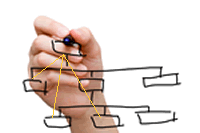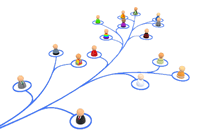- POPULAR ARTICLES
- Thank You Words
- Retirement Wishes
- Face to Face
Workplace Communication Dynamics
The main types of workplace communication are: Formal/Informal Communication, and Small Group Communication.
Formal interaction in the workplace takes place in a framework of authority and rules, some of them unspoken. Informal interaction is influenced by the culture of the organization .
Looking how people communicate in the workplace using this lens is useful because it makes it easier to appreciate the causes of certain behaviors at work.
We can more easily distinguish what behaviors are caused the be organizational structure and what behaviors are caused by individuals interacting as a group.
Formal Communication
 Formal communication is the information that flows upward, downward, and horizontally, among peers within an organizational structure.
Formal communication is the information that flows upward, downward, and horizontally, among peers within an organizational structure.
It also includes the diagonal interaction (aka matrix communication) that takes place within project teams, boards, committes, and task forces.
Informal or Grapevine Communication
Informal or grapevine communication flows in any direction, it doesn’t follow the organization structure.
 Informal communication can take place between all levels and all areas of the organization.
Informal communication can take place between all levels and all areas of the organization.
Informal relationships create a bond between people that help team become more cohesive and help people enjoy more the time they spend at the office.
In addition to useful information, the grapevine is used to carry rumors and gossip. Rumors in the Workplace are a fact of life, most people at work engage in some form of rumor spreading. Still, the rumor mill needs to be managed to reduce the harm that rumors and gossip may cause.
Small Group Communication
Small group communication includes: staff meetings, planning sessions, working sessions, project team meetings and committee meetings, board meetings and any other small group that meets and communicates.In small groups, a facilitator leads the discussion and the group participates as needed. The dynamics of small groups are different than those of large groups or one-on-one interactions.
In a group, the individual is affected by the attitude of the leader and the attitude of other members of the group. The need to look good (or avoid looking bad) is stronger. People may also bring their own agendas to influence the group beyond the pre-established group goals. Individuals may also tend to agree with the group to avoid confrontations, a dynamic known as groupthink.
Small groups can meet face to face or remotely aided by technology. The dynamics are almost the same, the difference is that they play out via text or video on a screen; or voice on a telephone. The absence of presence does influence the way small groups communicate, but to a small degree.
To sum up: It's useful to look at workplace communication from this angle: formal v. informal communication. Doing so allows us to more easily see how the way people communicate at work is shaped by (1) rules and organizational structure and (2) individual personalities.
Check out the most frequently asked questions here: Workplace Communication FAQ
Visit the Free Management Library for additional information on organizational communication.




